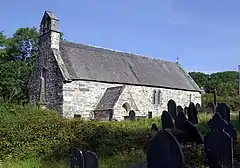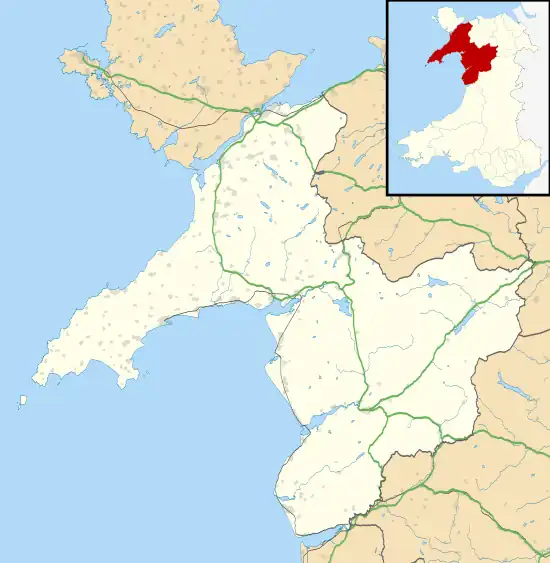Llanfrothen
Llanfrothen (ⓘ) is a hamlet and community in the county of Gwynedd, Wales, between the towns of Porthmadog and Blaenau Ffestiniog and is 108.1 miles (174.0 km) from Cardiff.[1][2] In 2011 the population of Llanfrothen was 437 with 70.1% of them able to speak Welsh.[3]
| Llanfrothen | |
|---|---|
 | |
 Llanfrothen Location within Gwynedd | |
| Population | 437 |
| OS grid reference | SH 6229 4121 |
| • Cardiff | 108.1 mi (174.0 km) |
| • London | 193.6 mi (311.6 km) |
| Community |
|
| Principal area | |
| Country | Wales |
| Sovereign state | United Kingdom |
| Post town | Penrhyndeudraeth |
| Police | North Wales |
| Fire | North Wales |
| Ambulance | Welsh |
Parc, a Grade II* Listed Building is within the community, as are the village of Garreg and the hamlet of Croesor.
The church at Llanfrothen is dedicated to St Brothen and is a Grade 1 listed building and is in the care of the Friends of Friendless Churches
The church and parish achieved prominence throughout Wales in 1888 when David Lloyd George, then a young local solicitor, took a case involving burial rights in Llanfrothen churchyard on appeal to the Divisional Court of the Queen's Bench Division. The case became known as the Llanfrothen Burial Case, and decision of the Divisional Court established the right of the family of a deceased nonconformist to have his body buried in the parish churchyard, by a Baptist minister, and without using the Anglican burial service.[4]
References
- Bangor University Placenames Unit (Canolfan Bedwyr); Archived 12 May 2014 at the Wayback Machine accessed 9 May 2014
- Google Maps (Map). Google.
- Welsh Government website; 2011 Census Returns and stats; Archived 30 May 2014 at the Wayback Machine accessed 9 May 2014
- Stevens, Catrin (1 December 2002). "The 'Burial Question': Controversy and Conflict c. 1860–1890". The Welsh History Review. University of Wales Press. 21 (2): 328–356. doi:10.16922/whr.21.2.5.
